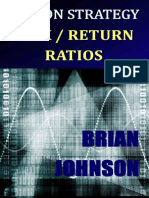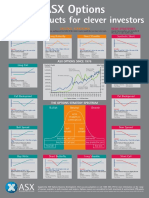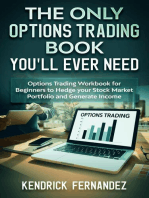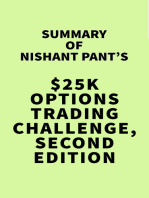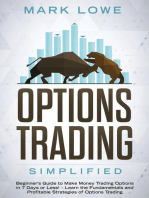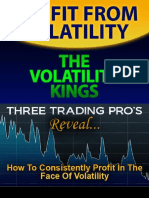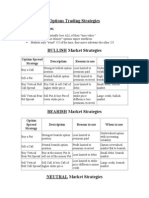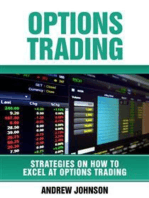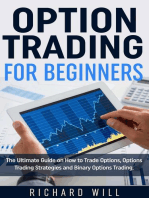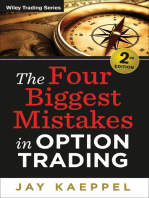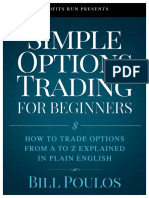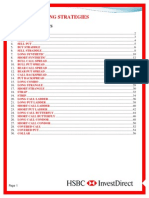Option Profit Accelerator
Uploaded by
Allan SorowonOption Profit Accelerator
Uploaded by
Allan SorowonOptions Profit Accelerator 1
Option Basics
In a letter to shareholders in 2002, Warren Buffett infamously said, “In our view, however, deriv-
atives are financial weapons of mass destruction, carrying dangers that, while now latent, are
potentially lethal.” Derivatives often have a negative connotation and many think they are just
tools for speculation with a high degree of leverage invented by mathematicians. However, I
don’t think that’s the case if you know how to use them properly.
Heck, derivatives have been around before all this fancy math and technology. The first reference
to a derivative-like security dates back to Genesis 29. That’s right, derivatives have actually been
around for thousands of years, whether traders like it or not.
In this guide, we will be discussing options and how to use them to your advantage while lever-
aging your capital.
First things first, we need to define options.
Options Profit Accelerator 2
Options Explained
An option contract in the finance world is ultimately just an option to buy or sell an underlying
asset, which could be a stock, index, futures or commodities. Here, we will be sticking with stock
options because it’s our community’s bread and butter. Quite simply, an option contract is just a
choice about whether you want to do something or not, it’s not different than any other options
we have in life.
A call option gives you the right to purchase the underlying stock at the specified strike price,
on or before the expiration date. On the other hand, a put option gives you the right to sell the
underlying stock at the strike price on or before the expiration date. When trading call or put
options on the long side, you pay a premium to receive the right to buy or sell 100 shares of the
underlying asset, and you’re not obligated to do so. That said, the amount of premium you paid is
the maximum amount you could lose.
●● The underlying stock is simply the product to which the option relates.
●● The strike price is the price at which you would buy or sell the stock.
●● The expiration date is the date that the option would stop trading. American options
could be exercised at any date before or up to the expiration date. American options
have nothing to do with the geographic location because they could be traded all
across the world.
On the other hand, if you short options, you would receive a premium for taking on the risk. If you
sell short, or write, a call option, you are obligated to sell shares of the underlying stock if the call
option holder exercises the option, or if the option expires in the money. If you write a put option,
you are obligated to purchase shares of the underlying stock, if the put option expires in the mon-
ey or the holder exercises the option.
Options Profit Accelerator 3
Here are some examples of options:
●● AAPL Feb 16 2018 170 Call
—— If you owned the call option, you would have to right to buy 100 shares of AAPL
at $170 per share, on or before the expiration date.
●● SBUX Feb 16 2018 58 Put
—— If you owned these SBUX put options, you would have the right to sell 100
shares at $58 per share, on or before the expiration date.
Moving on, let’s see how options are priced.
Options Pricing
There are a plethora of option pricing models out there, and we won’t go over them at all since
we’re sticking to the basics. Options pricing models involve heavy math, and I don’t think it’s nec-
essary to overwhelm you with all that information when you’re just starting out.
However, you do need to understand what factors affect option premium.
There are three major factors affecting option prices:
●● The underlying stock’s price
●● Time to expiration date
●● Volatility
The two “less” important factors affecting options prices:
●● Short-term interest rates
●● Dividends
Keep in mind that interest rates would matter in a rising rate environment.
Options Profit Accelerator 4
Underlying Stock’s Price
Again the underlying stock’s price movements affect option premiums.
For call options, when the underlying price rises, the premium should follow suit. Conversely, as
the underlying price rises, put option premiums fall. When the underlying price falls, call option
premiums would fall, while put option premiums would rise.
Time Value and Expiration
Typically, when there is a lot of time remaining until the option’s expiration date, the premium
would be higher. In other words, an option with two months until expiration would have a higher
premium than one with one week until expiration.
Volatility
Volatility is the underlying stock’s tendency to fluctuate in price. In other words, volatility reflects
the price change’s magnitude and does not have a bias toward price movement in one direction
or another.
The higher the volatility, the higher the option premium. The lower the volatility, the lower the
premium.
Interest Rates
Generally, interest rates do not affect premiums as much as the time value, the underlying stock
price and volatility. However, in a highly volatile interest rate environment, rates matter. An in-
crease in interest rates typically increases call prices and decreases put prices, based on the
famous Black-Scholes pricing model (we won’t get into the details of the options pricing model).
Dividends
Options are often priced assuming they would only be exercised on the expiration date. That
means if a stock issues a dividend, the call options could be discounted by as much as the divi-
Options Profit Accelerator 5
dend amount. However, put options would be more expensive since the stock price should drop
by the dividend amount after the ex-dividend date.
Now that we understand the basics of the factors affecting option premiums, let’s move onto
intrinsic and extrinsic value.
Intrinsic and Extrinsic Value
An option’s value is comprised of two components: intrinsic and extrinsic value.
The intrinsic value simply tells us the amount an option should be worth, when comparing the un-
derlying stock’s price and strike price. Let’s assume Apple (AAPL) is trading at $170, and you own
$160 call options. The options give you the right to buy the stock at $160, and therefore, the calls
should be worth at least $10 a piece, or $1K per contract.
If the call options were trading under $10, it would be possible for traders to buy the call, imme-
diately exercise the call to buy the stock for a net price below the current trading price. This is
known as a risk-free arbitrage profit, which cannot exist in the market, at least for a long time.
Arbitrageurs tend to eat those profits before you even get a chance to do any of that.
Now, if an option has not expired yet, it also has extrinsic value. The extrinsic value is an option val-
ue’s component, reflecting the fact the option has optionality. For example, let’s continue with our
AAPL option example. If AAPL is trading at $170, the $160 put options do not have any intrinsic val-
ue. You definitely do not want to exercise the option to sell AAPL shares at $160 when they’re trad-
ing at $170, that’s an instant loss. However, if the puts have enough time until its expiration date, it
could still have some value. This is because there is some probability that AAPL could trade down
to $150, and the puts would become in-the-money (ITM) and have intrinsic value of $10.
●● In-the-money, out-of-the-money and at-the-money just reflect an option’s moneyness in
relation to its strike price. For example, if a stock is trading at $50, the $40 strike price
Options Profit Accelerator 6
call options would be considered in-the-money, while the $40 strike price call options
would be considered out-of-the-money. Moreover, the $50 call and put options would
be considered at-the-money.
In short, extrinsic value reflects the value of owning the option because its intrinsic value could
rise in the future.
This brings us to the put-call parity.
Put-Call Parity
Put-call parity is a highly important relationship between puts and calls. Fundamentally, puts and
calls are the same thing. Put-call parity applies to only put and call options with the same strike
price and expiration date.
Let’s take a look at call and put option payoff diagrams to understand this important detail.
Here is an example of a put option payoff diagram:
The red is the option payoff, or profit-and-loss, diagram at the expiration date, while the blue line
is the current option price given different scenarios where the underlying is trading.
Options Profit Accelerator 7
Similarly, here’s an example of a call option diagram:
Everything is exactly the same here. Same underlying, expiration date, volatility and interest rates.
Take a look at the symmetry of the option payoff diagrams above. If the underlying stock is
trading at $120, the calls have $20 of intrinsic value, while the puts will have no intrinsic value.
Conversely, if the underlying stock is trading at $80, the put options would have $20 of intrinsic
value, while the call options would be “worthless”.
The beauty about options is you could synthetically create various strategies with different call
and put options. Now, it’s possible to synthetically create a similar payoff profile of the $100 call
options, using the $100 puts and the underlying stock. All you need to do is simply hedge the
$100 strike price puts with the underlying stock, and let’s assume the stock is at $100. Here, we
would create a synthetic $100 call option. The same could be done to create put options with
calls and the underlying stock.
Again, this is a very important detail for option traders. Quite simply, the only difference in a call’s
value and a put’s value with the same strike price and expiration date is the intrinsic value. If
you recall, intrinsic value is the value that an in-the-money option must have by being ITM. That
means an option must be worth as much as the difference between the strike price and the un-
Options Profit Accelerator 8
derlying stock price. For call options, its the maximum of 0 and the underlying stock price minus
the strike price. For put options, its the maximum of 0 and the strike price minus the underlying
stock price.
Remember when we said an option’s value has two components? Well, the extrinsic value is the
remainder of the option’s value once you’ve figured out the extrinsic value. Due to the put-call
parity, put and call options with the same strike, expiration and volatility should be worth the
same, in terms of extrinsic value.
What’s Next
Now that we’ve got the basics of options down, you’re well on your way to learn how to use op-
tions and some basic strategies. I know, this is a lot at first, but once you’ve got the basics down,
it’ll be a lot easier. You might need to go back a few times to review this before you move onto
the next section of the guide.
Options Profit Accelerator 9
Ways to Trade Options
If you recall from our first section, options allow you to be creative with trading. Options are one
of the most flexible asset classes in the market because you could accurately reflect your view on
the market.
For example, if you are bullish on a stock that is optionable, or has options, you could place a di-
rectional bet. The same is true when you’re bearish or neutral. Moreover, if you expect a stock to
move a lot, you could place a volatility strategy. You could also use options to hedge your stock.
The possibilities are pretty much “endless”.
Now, let’s take a look at ways to use options.
Using Options for Directional Trading
Options could be used to gain exposure to the price movements of the underlying stock. This is
known as directionally trading options and it’s what we’re all about. For example, if you are bullish
on a stock and think it could rise by $10, you could buy some call options to profit from a move up
in the underlying stock.
For example, let’s assume you think a stock could rise by $10 in one month, and the underlying
stock is trading at $50. You go out and purchase one $50 strike price call option expiring next
month for $1.59. Since stock options have a multiplier of $100, your risk would just be $1.59
Options Profit Accelerator 10
Well, here’s how your PnL would look at expiration:
Well, if you look at the chart above, if your option rises to $60 before the expiration date, it would
be worth at least $10 (or $60 minus the strike price, here it’s $50). If it stays above $60 and the
options expire, you would automatically be exercised since the options expired in-the-money and
you would be long 100 shares of the underlying stock at $50 and essentially, you could sell them
at $60 (assuming the stock doesn’t gap up or down hard overnight).
Another way you could express your bullish opinion on the stock would be to write put options.
Now, this is highly dangerous and I don’t suggest beginners go out and do this even if they think
the stock is going to the moon. When you naked write, or short options, you have a high degree
of risk. What happens if the company goes bankrupt? Well, those put options would be really
expensive and you’ll have to give that money to your broker.
Options Profit Accelerator 11
Let’s assume you short one $50 strike price put option with the same expiration date and collect
$159 in premium. Here’s a look at the short put option profit and loss (PnL) at expiration:
Just look at that, the risk-reward isn’t there. It does not make sense to collect $159 to potentially
lose $5K, or ($50 * 100), in the worst case.
Now, you could also express your bearish opinion on a stock with put options. Let’s say you no-
tice a negative press release in a stock and think it could fall 10% in 1 week. Assume the stock is
trading at $100 when this press release came out, and you were able to buy the $100 put options
expiring next week for $1.65, or $165 per contract.
Options Profit Accelerator 12
Here’s how your PnL would look at expiration:
Well, if the stock does fall to $90 before expiration, the put option contract would be worth at least
$10. You would pocket $8.65, or $10 less $1.65 (what you paid for the options), if you’re able to sell
them before expiration for just the intrinsic value. This is assuming there’s no extrinsic value left at all.
Hedging Your Stocks
You could also use options to hedge your stock position. For example, if you are long stock, but
are afraid of a short-term fall, you could hedge your stock position by purchasing put options. If you
think the stock will rise over the long term, but sell out of your position, you’ll probably end up kick-
ing yourself if the stock drops 2% then rises 10% in a month. Think of this as insurance. You could
protect your stock position over the short term but still take part if the stock rises over the long term.
If the underlying stock price rises, you would profit by owning the stock, but you would lose the
premium paid for the put. That said, could be used to alter your risk profile of a stock or portfolio
to fit your needs.
Options Profit Accelerator 13
Remember the call option PnL diagram at expiration? Well, here’s how your position would look if
you’re long 1 put option with a strike price of $100 and 100 shares of the underlying:
Keep in mind you would multiply the scale by 100. Now, if the stock falls significantly, you would
be protected. The blue straight line is your stock position, and the other plot is your long stock
and put position at expiration. This is known as a married put, and it looks pretty similar to the call
option payoff diagram right? Well, in essence, it is. You’re long the stock and if it rises you’ll profit,
but if the stock price falls, you’re hedged and could exercise your option and your maximum loss
is premium paid.
Options Profit Accelerator 14
Writing Options to Generate Income
Remember, you could also short options to collect premium, or generate income. Again, I don’t
think this is useful for beginning option traders because it’s extremely risky, if you’re not hedged,
but it’s worth going over.
This strategy hinges on the fact some options have extrinsic value, which will be gone by the time
the options expire. So, the idea here is that by selling options, the fall in value, also known as time
decay, could be captured for a profit. Even though the extrinsic value will fall as the option gets
closer to its expiration, or maturity, date, the intrinsic value could still rise.
Let’s take a look at an example. We’ll go over the covered call strategy here. A covered call strat-
egy is comprised of a long stock position and a short call position.
Now, if you own a stock, you could enhance your returns by selling out-of-the-money call options
on the underlying stock. If the stock price falls, you would lose money, but the calls will expire
worthless and you would minimize your losses because you collected that premium.
On the flip side, if the stock rallies and continues to make highs, you would profit from the rise
in the stock’s value. However, you would lose money on the short call position. Theoretically, a
call option as unlimited upside potential because we simply don’t know where the stock could
go. Since you are hedged with the position, if you are exercised on those options, you would still
profit, which would be equivalent to the strike price of the call option less the purchase price of
the stock. There’s a tradeoff here. What if the stock is in buyout talks and it rises 40%, well your
upside is limited. You maximum loss would be limited to the price you paid for the stock less the
premium you received, if the stock starts to drop below the strike. That said, I think you should
stick to directional trading and we’ll discuss this in How to Capture 100% Profits on Small Moves
in Stocks.
Options Profit Accelerator 15
Trading Volatility with Options
One of the primary reasons to trade options is to gain exposure to or protect your position
against volatility. If you recall from the section on Basic Option Strategies, one of the three
essential components of an option’s price is the underlying stock’s volatility. Now, you might be
wondering why would anyone want to “trade” volatility?
Well, volatility is often viewed as an asset class. There are various derivatives allowing traders to
gain exposure to volatility, such as variance and volatility swaps. Since volatility impacts nearly all
trading strategies, it’s become important to traders to manage that risk or capitalize on changes
in the level of volatility.
Volatility is one of the most important factors of an option’s value, and we’ll leave you with a sim-
ple strategy.
Let’s assume you think a stock is going to move significantly after its earnings announcement, but
you don’t know in which direction. Well, you could put a straddle on, which is a play on volatility.
For example, if the underlying stock is trading at $100 and it’s reporting its quarterly earnings this
week, you could put on a straddle. You could do this by simply purchasing at-the-money call and
put options.
Options Profit Accelerator 16
Here’s how your PnL would look at expiration:
Take note that the red line is just what the strategy would currently be worth, while the blue line is
the option’s value on the expiration date.
It’s pretty clear that you could make money if the stock moves a lot in either direction.
There are various ways to use options, but when you’re first starting out, I think you should only place
directional bets. When you start getting the hang of things and profiting, then you could move onto
hedging your stock or placing volatility trades. Now, in the next section, Understanding Implied
Volatility, we’re going to go over implied volatility, which is one factor beginning option traders have a
tough time grasping. Again, options may seem tedious at first, so you’ll need to continue studying this
guide to understand the way options really work, and this could help you with your trading success.
Options Profit Accelerator 17
Implied Volatility Explained
Implied volatility originates from the options market. Typically, with stocks, you just have realized,
or historical volatility. In other words, how much a stock has moved historically, in percentage
terms.
Recall that there are several factors affecting an option’s price including: the underlying stock’s
current price in relation to the strike price and time to maturity. The others (dividends and interest
rates) are not as important. Another important factor is the expected volatility of the underlying
stock over the option’s life.
Now, for an out-of-the-money option to be worth anything, there has to be some probability that
it could expire in-the-money. Otherwise, there’s no point to trade options minus the fact that they
help to leverage your capital. That said, the underlying stock needs to have some price volatility.
That means, the stock’s price needs to move in order for the option to become valuable.
Now, the more volatile the stock, the more valuable the option will be. No matter what type of op-
tion, whether it be a call or a put option. Think of tech or healthcare stocks. If you have seen these
stocks in action, you’ll know that they move a lot. Therefore, options on those types of stocks
would be more expensive because there is a higher probability they could expire in the money.
This is a bit tedious to understand at first, but it’ll make sense once you read it a few times. Since
you can uniquely identify an option’s value with one level of expected, or implied, volatility, the
option value inherently implies the expected volatility level. Now, we won’t get into the mathe-
matics of options pricing model because it involves working knowledge of stochastic differential
equations, probability and partial differential equations. We’ll leave that to the math geniuses at
the NYU Courant School of Mathematics or Columbia’s Financial Engineering Department.
Options Profit Accelerator 18
Getting back on track, in order to calculate an option’s value, the factors affecting an option’s
price is plugged into the model. You would need to work in reverse and start with the option val-
ue and all the other factors except the expected volatility. All you would need to do is rearrange
the formula and make the expected volatility level the point. Good thing we have trading plat-
forms that do all that for you. Again, you don’t need to do any maths to find the implied volatility.
That said, let’s skip over how implied volatility is actually calculated and look at how to interpret
implied volatility figures.
Interpreting Implied Volatility Figures
Take out all the math, and implied volatility numbers are intuitive. Let’s make this easy to under-
stand.
One way to interpret implied volatility is by looking at expected standard deviation in the underly-
ing stock price for the upcoming year. Now, standard deviation is simply the dispersion of a set of
data points, here it’s just the stock prices.
For example, assume an at-the-money option expiring in one year on a stock has an implied vol-
atility of 40%. You could interpret this as: Over the next year, the option market expects the stock
to move 40% in either direction.
There are a lot of assumptions behind the implied volatility. In the example, we use an option
expiring in one year. Well, you might be wondering, Could I use the the implied volatility for one
month? You can’t really do this in practice. Sticking with the same example, the implied volatility
used to price the option, even though it’s an annualized figure, it really only relates to the expect-
ed volatility over the option’s life. That in mind, it would not make sense for you to use the implied
volatility for one month, if the option is expiring in one year. The one month implied volatility does
not really tell you anything about an option expiring in one year’s time.
Options Profit Accelerator 19
Now, you must be careful if you’re converting an implied volatility into a stock’s expected range
one year from now. It’s possible to compare implied volatilities across different stocks and stock
indices because implied volatility is quoted in percentage terms, and therefore, it’s indepent of
the underlying stock price or index level.
If it’s difficult to figure out how much a stock should move per day, given the annualized implied
volatility. You could easily convert the annualized implied volatility figure into a daily standard
deviation, or implied volatility. This is fairly common practice and I do this often too. Generally,
option traders have a good feel for how much a stock should move day-to-day, but it’s harder to
have a feel for price movements in a week, month or year. I know, I know, this doesn’t really make
sense. There’s a disconnect here.
Implied volatility is shown in annual terms, but the historical volatility experienced in the stock is
matters on a daily basis. You care about what your PnL and the volatility level is today, not in a
year.
Let’s take a look at how you could convert the annual volatility level. This is quite simple to do.
Converting the annualized implied volatility into a daily number is simple. All you would need to
do is divide the implied volatility by the square root of a time frame. For instance, if you want to
figure out what the options market is implying about the stock’s price movement in one month,
you would divide the annualized figure by the square root of 12, since there are 12 months in a
year. For example, let’s assume the annual implied volatility of a specific call option contract on
Facebook (FB) is 70%.
Here’s how you would calculate the monthly volatility:
F B Monthly Implied Volatility = 0.70 ÷ (√12) = 20.23%
Options Profit Accelerator 20
Now, a more common conversion is from annualized to daily. We would use 252 trading days be-
cause that’s the convention. The square root of 252 is 15.87. So dividing the annualized by 15.87
would give you a rough estimate of the daily implied vol.
Here’s the calculation, continuing with the FB example:
F B Daily Implied Volatility = 0.70 ÷ √252 = 4.41%
That means the options market is expecting a 4.41% move for that specific strike price and expira-
tion date.
Now, if you multiply this by FB’s current stock price, it gives you a rough estimate of FB’s daily
move in terms of dollars and cents. This gives you an idea of theoretical prices changes in the
underlying stock that the options are currently pricing in.
You could also use implied volatility as the “price” of options. In addition to interpreting implied
volatility as the underlying stock’s standard deviation, implied volatility could be viewed as the
option’s price.
Now, the implied volatility is uniquely mapped to the option value. Remember, higher implied volatili-
ty means higher option prices, and you could use these interchangeably. Options traders like to use
implied volatility to quote an option’s value because there’s an edge over an option’s dollar value.
Remember, there are three main components of an option’s value, and the underlying stock
price is one of them. In dollar terms, an option’s value is highly sensitive to the underlying stock
price. This is known as an option’s delta. Now, this is out of the scope for what we’re trying to do.
But the delta is simply an option’s sensitivity to the underlying stock price. For example, if a call
option has a delta of $0.50, for every $1 move up the option would gain 50 cents. However, if the
underlying moves down $1, then the call would lose 50 cents.
Options Profit Accelerator 21
To volatility traders, the intrinsic value is just noise, which is driven by the underlying stock price.
It really doesn’t tell them about the option’s value that is due to the extrinsic value.
Just know that the dollar value of an option is sensitive to the price change in the underlying. In
other words, if you’re long a call option and the option value increased, but the implied volatility
remained the same, this is only because the intrinsic value increased.
In implied volatility terms, the option value is the same. This is one interesting and important fac-
tor to grasp. Now, if you did not know what the underlying stock price was, you would not know if
the call option price increased due to an increase in implied volatility or if the stock price moved
up. However, if you’re at implied volatility changes, you could pinpoint exactly why the option
price changed. Keep in mind we’re assuming rates are the same and the stock does not pay a
dividend.
Since we’ve got a good idea of what implied volatility is, we’re going to look at what affects im-
plied volatility.
Options Profit Accelerator 22
Factors Affecting Implied Volatility
Let’s take a look at three important factors that affect implied volatility. These factors are not all
independent and there could be a ripple effect if one changes significantly.
●● The supply and demand for options.
Supply and demand affect the market and is one of the key factors affecting prices,
whether it be stocks or options. Remember, implied volatility is one of the primary fac-
tors affecting option prices. Moreover, implied volatility could be used to quote options
prices. That said, supply and demand will cause changes to an option’s price, and there-
fore implied volatility.
If the traders want to buy options, the option would be bid up, causing a rise in prices
and implied volatility will follow suit.
Now, what drives supply and demand? Well, it’s hard to say. Supply and demand for op-
tions could depend on trader sentiment. It could also depend on the implied vol level.
For example, let’s assume a stock’s volatility is below the implied vol in the options mar-
ket. Assume the company is expected to make a big announcement soon. The demand
for options would be high due to the uncertainty of what the company might say, re-
gardless of the current actual vol level. What if the company has a press release and the
stock price runs up after. Now, what typically happens is the implied vol will fall sharply.
We see this with earnings releases all the time. Implied vol runs up into earnings, then
wham. The vol gets sucked out after because there’s no more uncertainty. The demand
for options falls, and there’s an oversupply of those contracts because traders may be
looking to liquidate their options.
Remember in the Ways to Trade Options section, one way to use options would be to
hedge your stock position. Now, the higher the degree of uncertainty over the future
stock price volatility, the greater the demand for options as hedges. This leads to higher
prices and implied vol.
Options Profit Accelerator 23
For example, if a stock is near all-time highs, you might see a greater demand for puts
because longs might be worried of a pull back and bid up the put option prices.
●● Recent Historical Implied Volatility.
Keep in mind, implied vol is forward looking. However, this does not mean we’re memor-
yless and forget about the historical volatility. Volatility is known to cluster around certain
levels. Consequently, you could have a reasonable estimate of tomorrow’s volatility by
looking at the recent realized volatility. So it should not be surprising to you that that
implied volatility often relates to historical vol.
For example, if a stock’s price has an annual historical volatility of 25%, and it’s done that
every year, more or less, over the last decade. Then it’s probably a good estimate that
the implied vol this year would be 25%, all else being equal.
However, what happens if implied vol for a specific options contract, say the call options,
is 60%. Well, something is up. If this is the case, clearly someone knows something or
has high expectations the stock could run up.
Over the longer run, there’s a low probability that implied vol and historical vol will
significantly diverge in one direction. Now, quick and large changes in actual vol levels
should impact implied volatility. Again, since realized vol tends to cluster, implied vol
does too. That said, implied vol is likely to resemble historic volatility Now, if you no-
tice large discrepancies between the two different volatilities, there could be a trading
opportunity or reflect some some new information that could affect the underlying stock
price that you might not have seen before.
Options Profit Accelerator 24
●● Changes in the market’s expectation of the underlying stock.
I know, I sound like a broken record, but Implied volatility reflects the current expecta-
tion of future realized vol of the underlying stock price. Now, these changes could be
due to a number of factors. Maybe there’s a potential press release or the market might
have clues about earnings. The greater the stock’s price sensitivity to potential news
and earnings, the higher the implied vol due to the increased uncertainty.
Take note that the traders could be wrong about implied volatility Everyone has an opin-
ion, but the market doesn’t care about opinions, sometimes.
Now, some ways to trade implied vol would be:
●● Trading against technical levels in implied vol or moving averages
●● Trading implied vol ahead of corporate announcements like earnings
Implied volatility is one factor you need to understand if you’re looking to trade options. It’s what
drives the extrinsic value of option prices. Now that we’ve gone over most of the basics of op-
tions, you’re ready for what most of you have probably been waiting for: How to Capture 100%
Profits on Small Moves in Stocks. Now, make sure you understand the concepts in this section
and the previous two before moving on because it’ll be a lot easier for you to understand how
you could capture 100% profits on small moves in stocks.
Options Profit Accelerator 25
How to Capture 100% Profits
on Small Moves in Stocks
Now, we’re going to focus on directional plays here because that’s our bread-and-butter in our
community.
First things first, let’s look at an option’s chain for Netflix (NFLX):
Source: Yahoo Finance
Options Profit Accelerator 26
Source: Yahoo Finance
We wanted to make things simple for you to do, and you can access options chains from Yahoo
Finance or Nasdaq before you start live trading options. Options chains are the same across all
platforms and data providers. You have your strike price, the last price, the bid and ask price, the
volume traded, the open interest (how many contracts are still held) and implied volatility.
Let’s get right into things and highlight some trades that were good for 100%.
Timing is Key, Weekly Money Multiplier Highlights
Timing is key when you’re trading. Let’s say you think gold miners will fall over the next few
weeks, so you purchase put options in the VanEck Vectors Gold Miners ETF (GDX).
Well, if you’re timing is off, you would lose your entire premium. This is where technicals and mar-
ket experience come into play.
Options Profit Accelerator 27
Here’s a look at GDX on the hourly chart:
If you notice, there are two places I annotated the chart. One where the 13 SMA broke above the
30 SMA, which is a bullish signal. Now, I watched this rise over the entire time and missed the
move. However, I figured this was topping out, so I purchased 200 GDX put options with a strike
price of $23.50 expiring on January 19, 2018 at 28 cents a piece (so $5,600 in premium).
Now, I noticed my “money pattern” and believed this thing was going to pull in hard. So with
the stock trading around $23.50, I purchased at-the-money put options, thinking it would break
Options Profit Accelerator 28
lower. I was looking for a quick drop, and we got just that. The options more than doubled, and I
was able to net $5,800 on just a $5,600 investment. Not a bad trade! This all happened within 3
days (that included weekends too). On just a small move (around 3% or 70 cents in GDX), the op-
tions gained some intrinsic value and went up 29 cents to 57 cents. That’s the power of options.
Instead of making 70 cents and using a lot of capital, I was able to use just $5,600 to generate
105% in profits, this isn’t really possible in the stock market. Although some stocks do double, it
doesn’t happen as much as it does in the options market.
Let’s take a look at another example. Our community was watching the small caps index in early
January 2018. Our thesis was the market was strong and small caps were going to outperform to
kick off 2018.
Rather than going out and buying the iShares Russell 2000 ETF (IWM), which would be extremely
expensive, we went out and bought calls.
Here’s the email we sent out to the community:
Options Profit Accelerator 29
Here’s a look at IWM on the hourly chart:
Now, we bought $154 IWM call options expiring on January 12, 2018 and were looking for a 100%
gain on these options. Why the $154 strike price? Well, these were at-the-money and relatively
cheap, and we had a feeling this was going to spike higher. These calls were only 85 cents, so
my risk was $5,100 (and that’s if IWM fell and I wasn’t able to get out before the expiration date
for a small loss).
Well, sure enough, these doubled to $1.70 in just two days because the ETF moved up to $155.
Options Profit Accelerator 30
This wasn’t the only trade we had in IWM.
At the time, I figured the market was going to run much higher even after we doubled up on pre-
vious options trade. There was some weakness after IWM failed to break about $155.50. Well, I
bought on that weakness.
Here’s a look at my thought process:
Options Profit Accelerator 31
Well, we can’t always go for 100%. On this trade our community settled for 60%.
Options Profit Accelerator 32
Now, the iShares 20+ Year Treasury Bond ETF (TLT) was also on our radar.
Here’s what our thought process was:
Options Profit Accelerator 33
Take a look at the hourly chart when we got into the trade on January 17, 2018:
We figured with rates set to rise and strong economic outlook, bond prices had a high probability
of falling. To confirm our thesis, we had the 13 SMA cross below the 30 SMA.
Options Profit Accelerator 34
Options Profit Accelerator 35
We took that off the table for +130%. Well, how was that possible? TLT dropped over a point, that
meant the options became more intrinsically valuable, therefore, the stock price increased.
Now, I’m not telling you it’ll be easy to make 100% on small moves. But it’s highly possible to
make over 50% on your options trades on small movements. It’ll take you some time an expe-
rience, but if you have a mentor who has battle-tested strategies, well you’re able to flatten the
learning curve. Things will be much easier if you have people around you to answer questions
about options. Let’s face it, options could be difficult to trade when you start, but when you have
experience people around you, you’ll pick up on them a lot quicker.
Options Profit Accelerator 36
Bonus Section
Jeff’s Inside Secret
Traders don’t usually associate options trading with technical patterns. However, through experi-
ence and constantly testing a key technical indicator for entries, it’s shown to potentially generate
more than 100% returns. Now, you might be wondering, “How’s that possible?” Well, it’s simple,
you select specific options, look for the money pattern and use options as a directional play. With
some options, all you need is a small move in the stock price, and the options could double or
even triple in a few days.
Well, this money pattern is your friend and a powerful trading tool. First, you’ll need to understand
simple moving average crossovers. Basically, you can take high-probability trades by mastering
the 13/30 hourly-crossover pattern. If the 13-hourly simple moving average (SMA) crosses above
or below the 30-hourly SMA, that alerts you to buy specific options. This pattern produces clean
signals to trade with and you’re using options to leverage the battle-tested signal.
First things first, let’s take a look at how to set up your charts.
Indicators and Charts
If you have a brokerage platform you like to use, it should have simple moving averages. All you need
to do is set the time frame to hourly, and plot the 13-period, 30-period and 200-period SMAs.
If you don’t have charting software, that’s fine. There are plenty of free charting websites out
there, such as TradingView, Investing.com and Stockcharts.com.
Options Profit Accelerator 37
For example, here’s a look at how I set up all my charts.
Now, if the 13-period SMA cross-
es above the 30-period SMA on
the hourly, it’s considered a bull-
ish crossover. Conversely, if the
13-hourly SMA crosses below the
30-period SMA, it’s considered
bearish. That in mind, we look to
buy calls on a bullish crossover
and buy puts on a bearish cross-
over. It’s that simple.
Moreover, the 200-hourly SMA
can give you a good idea of the
longer term trend and could act
as a support or resistance level.
Next, you need to understand the basics of support and resistance. Support is an area where a
stock has had a hard time breaking below. Think of it as a “floor” and traders are willing to step
in and buy the stock at that price. Resistance is the exact opposite of support. Resistance is like a
“ceiling” and traders are either selling their stock or short selling it at the area. In other words, stocks
tend to bounce off of support areas and fail at resistance.
For you to really understand the money pattern, let’s take a look at some real trades. I actually trad-
ed these names and bought options on the underlying stock, depending on the 13/30 hourly cross-
over pattern. If you get the hang of this, it’s not rare for you to double your money, or more, in just a
few days to weeks. Don’t worry if you don’t know what support and resistance, or if any of this isn’t
clear. Once you see how these tools work in real trades, it’s not that difficult to spot them.
Options Profit Accelerator 38
The “Money Pattern” Examples
Alarm.com Holdings Inc (ALRM) is one perfect example of how you could multiply your money in
just a short period. Here’s a look at the chart and what we were looking at.
Here’s a look at ALRM before we bought options on the stock. You can clearly see the $39 area
was support. In other words, ALRM had a tough time breaking below this area. That said, we
were looking to buy call options on ALRM, anticipating a move higher. Now, a higher probability
trade would have been to wait for the 13-hourly SMA to actually cross above the 30-hourly SMA.
Notice how the 13-hourly SMA (the blue line) looks like it’s going to cross above the 30-hourly
SMA (the red line). This pattern was just starting to flash “buy”.
ALRM is a strong stock that just pulled back, and I wanted to take advantage of it. The stock still
seemed strong, and was holding up fairly well.
Options Profit Accelerator 39
Take a look at the plan above. I bought the call options expiring on June 15, 2018 on May 9, 2018
at $1.20. I was looking to add more if the calls pulled back to the $0.80’s. Moreover, I would stop
out if the options fell around $0.60. Now, this is something you should always do when you’re
trading. Always have a plan and specify where you would buy more and stop out of your position.
Here’s a look at what happened with ALRM.
Options Profit Accelerator 40
The 13-hourly SMA crossed above the 30-hourly SMA, as shown in the encircled area. The stock
got a nice pop and had a nice move to the upside. The options doubled and we were sitting on
some nice profits.
That’s right, that small investment turned into $14K.
If you were to do this with stock, it would be a lot
harder to see returns like this. This is due to the fact
that stocks are linear. In other words, if you’re long
1K shares of a stock and it moves up $1, you make
$1,000. However, with options, you’re able to gener-
ate high returns with a “small” initial investment be-
cause they provide leverage and are non-linear. If a
stock runs up just a few bucks, the call options could
more than double, depending on the strike price and
expiration date.
Options Profit Accelerator 41
The takeaways from this trade are:
● ALRM found support around the $39 area and was a strong stock
● The 13-hourly SMA looked to potentially cross above the 30-hourly SMA
● Just buying at-the-money (ATM) call options was a good play. (You should have a good under-
standing of moneyness, but if you don’t, ATM just means the strike price of the options is near the
stock’s current price.)
Let’s take a look at another example of the 13/30-hourly SMA crossover in action.
The Global X MSCI Greece ETF (GREK) was another trade that we used the 13/30-hourly SMA
crossover to get in. This time, puts were involved. Rather than shorting the exchange-trade fund
(ETF), which could lead to large unexpected losses, we bought put options. Remember, put
options allow us to express our bearish opinion on a stock or ETF. Keep in mind, when you pur-
chase options, the maximum you could lose is the amount of premium paid.
GREK had a clear long signal,
but I missed out on this one. It
had a move from around $9.60
to more than $10.80. This time,
the 13-hourly SMA was changing
direction and looked to cross
below the 30-hourly SMA. So
what do we do here? We buy
puts because, again, when the
13-hourly crosses below the
30-hourly, it signals the
stock price could fall.
Options Profit Accelerator 42
I wasn’t going to miss out on this trade after I saw the ETF run higher after the buy signal. Now,
it’s indicating it could fall.
I bought put options expiring on May 18, 2018 with a strike price of $11 for just 50 cents on April
20, 2018.
Keep in mind, the ETF made a high of $10.81, and I would have stopped out if the stock broke
above that level. When you’re wrong, you have to realize that and just cut your losses quick. The
ETF did try to make a new high above $10.81, but failed. I was close to stopping out of my posi-
tion, but luckily, GREK didn’t make a new high.
Options Profit Accelerator 43
Here’s what happened with the ETF.
When the ETF started pulling in, I figured it was a good time to start taking profits.
Options Profit Accelerator 44
Even though I wasn’t up 100% on the options position, it was prudent to take profits when the
puts were up 70%. When you’re up, you should always look to take profits and let the rest run,
and that’s what happened with the put options on GREK.
Take a look at what happened with the ETF.
The ETF continued to collapse and the options more than doubled!
Options Profit Accelerator 45
Again, this isn’t an unusual trade in the op-
tions market. By holding onto a portion of the
position, the trade generated an additional
$12K. If you traded this ETF, you would’ve had
to short around 10K shares, just to make the
same amount, which would eat up your buying
power.
Moving on, let’s look at another options trade that generated a high return with just a little bit of capital.
TripAdvisor Inc (TRIP) had an excellent breakout on strong earnings. However, it’s best not to
chase stocks. Rather, you should wait for it to consolidate and show you a clear entry.
If you look at the chart above, you can clearly see the support area is around the $47.60s. The
stock started to trend higher after consolidating. That in mind, this was a good time to buy call
options since the trend was rising. When this happens, you can ride the trend as long as the tide
doesn’t change.
Options Profit Accelerator 46
If the stock broke below the support area, that would’ve been an indication to sell the call options.
However, that didn’t happen. Here’s what the stock actually did.
The 13-hourly SMA crossed above the 30-hourly SMA earlier, and TRIP started to trend higher.
In just a matter of days, the options went up over 200%.
Options Profit Accelerator 47
Remember, it’s always good to take profits when the option prices are near your targets. TRIP continued
higher, and the stock was up 20% from when I purchased the calls. This was a good time to take profits.
Options Profit Accelerator 48
The options trade returned nearly 500% on a $6,500
investment. If you wanted to do that with stock, you
would have to buy around 3,000 shares, which
would’ve been over $130K just to make the same
amount. Moreover, you would have to be nearly
perfect if you were trading the stock to get the same
profits in dollar terms.
Now, another reason to trade options is due to the fact that not everyone has the amount of capital to
trade high dollar names. For example, Chipotle Mexican Grill Inc (CMG) was trading over $400 and just 100
shares would’ve costed you over $40K! Here’s a look at a trade where you could have purchased options on
CMG and more than doubled your money.
Notice the fake out here. The stock gapped up and the 13-hourly SMA crossed above the 30-hourly SMA.
If you bought the stock there, you would’ve paid up and potentially got stopped out. You need to take into
account the fakeout breakout when using this indicator. The stock broke above resistance, only to pull in.
However, it started to consolidate, and there was no clear direction yet.
Options Profit Accelerator 49
In just a matter of days, CMG found some support around the $429 area. Thereafter, the 13-hourly SMA
clearly crossed above the 30-hourly SMA and trended higher.
Rather than buying 100 shares of the stock, which would’ve costed you around $40,000, you could have
purchase 1 call option at $8.85. 1 call option leverages 100 shares, and was only $8,850 in premium.
Notice how the plan was clearly laid out. There were spots where I was willing to add and a price
where I would’ve stopped out. This was another “easy” trade following the hourly-crossover indi-
cator. CMG never broke below $425, so I stayed in the trade.
Options Profit Accelerator 50
That’s right, the options trade was good
for a 216% return! That’s really hard to do
when trading the stock alone.
Final Words
Now, you should have a good idea of how to use the 13/30-hourly crossover. However, this takes time and
grit to truly understand how to use the indicators. You’ll need to continue looking at charts and trying to find
trades. When you’re first starting out, it always helps to have a mentor to guide you along the way, espe-
cially if you’re trying start trading options.
Options Profit Accelerator 51
You might also like
- Trading Implied Volatility: Extrinsiq Advanced Options Trading Guides, #4From EverandTrading Implied Volatility: Extrinsiq Advanced Options Trading Guides, #44/5 (1)
- Options For Swing Trading by Michael C. Thomsett100% (10)Options For Swing Trading by Michael C. Thomsett349 pages
- Brian Johnson Option Strategy Risk Return Ratios: A Revolutionary New Approach To Optimizing, Adjusting, and Trading Any Option Income Strategy100% (16)Brian Johnson Option Strategy Risk Return Ratios: A Revolutionary New Approach To Optimizing, Adjusting, and Trading Any Option Income Strategy183 pages
- The Only Options Trading Book You'll Ever Need: Options Trading Workbook for Beginners to Hedge Your Stock Market Portfolio and Generate IncomeFrom EverandThe Only Options Trading Book You'll Ever Need: Options Trading Workbook for Beginners to Hedge Your Stock Market Portfolio and Generate IncomeNo ratings yet
- Summary of Nishant Pant's $25K Options Trading Challenge, Second EditionFrom EverandSummary of Nishant Pant's $25K Options Trading Challenge, Second EditionNo ratings yet
- Options Trading: Simplified – Beginner’s Guide to Make Money Trading Options in 7 Days or Less! – Learn the Fundamentals and Profitable Strategies of Options TradingFrom EverandOptions Trading: Simplified – Beginner’s Guide to Make Money Trading Options in 7 Days or Less! – Learn the Fundamentals and Profitable Strategies of Options Trading2/5 (1)
- Option Greeks in Plain English Mastery in Place Steven67% (6)Option Greeks in Plain English Mastery in Place Steven267 pages
- McMaster, Gavin - Volatility Trading Made Easy - Effective Strategies To Survive Severe Market Swings 2013100% (6)McMaster, Gavin - Volatility Trading Made Easy - Effective Strategies To Survive Severe Market Swings 201337 pages
- Mastering Option Trading Volatility Strategies With Sheldon Natenberg80% (5)Mastering Option Trading Volatility Strategies With Sheldon Natenberg31 pages
- Power: Passive Option Writing Exceptional Return StrategyFrom EverandPower: Passive Option Writing Exceptional Return StrategyNo ratings yet
- GW Pharmaceuticals (NASDAQ: GWPH) High As A Kite and Too Close To The SunNo ratings yetGW Pharmaceuticals (NASDAQ: GWPH) High As A Kite and Too Close To The Sun20 pages
- How To Win 97% of Your Options Trades Ebook PDF82% (11)How To Win 97% of Your Options Trades Ebook PDF24 pages
- Uncle Bobs Money: Generating Income with Conservative Options TradesFrom EverandUncle Bobs Money: Generating Income with Conservative Options Trades4/5 (6)
- Credit Spreads:Beginners Guide to Low Risk, Secure, Easy to Manage, Consistent Profit for Long Term WealthFrom EverandCredit Spreads:Beginners Guide to Low Risk, Secure, Easy to Manage, Consistent Profit for Long Term WealthNo ratings yet
- Options Wheel Strategy: How to Generate an Income Stream Using Cash Secured Puts and Covered CallsFrom EverandOptions Wheel Strategy: How to Generate an Income Stream Using Cash Secured Puts and Covered Calls1/5 (1)
- Options Trading: How To Excel At Options Trading: Strategies On How To Excel At TradingFrom EverandOptions Trading: How To Excel At Options Trading: Strategies On How To Excel At TradingNo ratings yet
- Option Trading for Beginners: The Ultimate Guide on How to Trade Options, Options Trading Strategies and Binary Options Trading.From EverandOption Trading for Beginners: The Ultimate Guide on How to Trade Options, Options Trading Strategies and Binary Options Trading.3/5 (2)
- Options Trading Strategies: 25 Option Trading Strategies That Can Bring You ProfitFrom EverandOptions Trading Strategies: 25 Option Trading Strategies That Can Bring You ProfitNo ratings yet
- Options Trading: How To Get From Zero To Six Figures With Options Trading Strategies & Options Trading For Beginners - Forex Trading & Penny Stocks Trading Stocks - Options Trading 2018From EverandOptions Trading: How To Get From Zero To Six Figures With Options Trading Strategies & Options Trading For Beginners - Forex Trading & Penny Stocks Trading Stocks - Options Trading 20181/5 (1)
- Generate Monthly Cash Flow by Selling Options100% (4)Generate Monthly Cash Flow by Selling Options23 pages
- How To Trade Options - 12 Tenets of Daily Trade DisciplineNo ratings yetHow To Trade Options - 12 Tenets of Daily Trade Discipline2 pages
- Using Options To Buy Stocks - Build Wealth With Little Risk and No Capital100% (1)Using Options To Buy Stocks - Build Wealth With Little Risk and No Capital534 pages
- FRM Part 1 - Test ID - 0003 - Topic - TVM + Mutual Funds - Questions - 50No ratings yetFRM Part 1 - Test ID - 0003 - Topic - TVM + Mutual Funds - Questions - 5013 pages
- Quantifeed White Paper - 13mar17 (002) DC PDFNo ratings yetQuantifeed White Paper - 13mar17 (002) DC PDF6 pages
- Assignment Fin242 Muhd Sharizan Bin MustafahNo ratings yetAssignment Fin242 Muhd Sharizan Bin Mustafah16 pages
- Times Interest Earned Ratio: Compare Interest Payments With Income Available To Pay ThemNo ratings yetTimes Interest Earned Ratio: Compare Interest Payments With Income Available To Pay Them13 pages
- TYBCOM - BANKING & FINANCE 365-B Financial Markets and Institutions in India - IINo ratings yetTYBCOM - BANKING & FINANCE 365-B Financial Markets and Institutions in India - II4 pages
- Session 6 Case Study Questions Workbrain Corp - A Case in Exit Strategy0% (1)Session 6 Case Study Questions Workbrain Corp - A Case in Exit Strategy2 pages
- Topic 6 - Preparation of A Business Plan For A Small BusinessNo ratings yetTopic 6 - Preparation of A Business Plan For A Small Business6 pages
- Tetra Bio-Pharma Audited Annual Financial Statements - Year Ending 30th November 2016No ratings yetTetra Bio-Pharma Audited Annual Financial Statements - Year Ending 30th November 201632 pages
- Trading Implied Volatility: Extrinsiq Advanced Options Trading Guides, #4From EverandTrading Implied Volatility: Extrinsiq Advanced Options Trading Guides, #4
- Brian Johnson Option Strategy Risk Return Ratios: A Revolutionary New Approach To Optimizing, Adjusting, and Trading Any Option Income StrategyBrian Johnson Option Strategy Risk Return Ratios: A Revolutionary New Approach To Optimizing, Adjusting, and Trading Any Option Income Strategy
- The Only Options Trading Book You'll Ever Need: Options Trading Workbook for Beginners to Hedge Your Stock Market Portfolio and Generate IncomeFrom EverandThe Only Options Trading Book You'll Ever Need: Options Trading Workbook for Beginners to Hedge Your Stock Market Portfolio and Generate Income
- Summary of Nishant Pant's $25K Options Trading Challenge, Second EditionFrom EverandSummary of Nishant Pant's $25K Options Trading Challenge, Second Edition
- Options Trading: Simplified – Beginner’s Guide to Make Money Trading Options in 7 Days or Less! – Learn the Fundamentals and Profitable Strategies of Options TradingFrom EverandOptions Trading: Simplified – Beginner’s Guide to Make Money Trading Options in 7 Days or Less! – Learn the Fundamentals and Profitable Strategies of Options Trading
- Option Greeks in Plain English Mastery in Place StevenOption Greeks in Plain English Mastery in Place Steven
- McMaster, Gavin - Volatility Trading Made Easy - Effective Strategies To Survive Severe Market Swings 2013McMaster, Gavin - Volatility Trading Made Easy - Effective Strategies To Survive Severe Market Swings 2013
- Mastering Option Trading Volatility Strategies With Sheldon NatenbergMastering Option Trading Volatility Strategies With Sheldon Natenberg
- Power: Passive Option Writing Exceptional Return StrategyFrom EverandPower: Passive Option Writing Exceptional Return Strategy
- GW Pharmaceuticals (NASDAQ: GWPH) High As A Kite and Too Close To The SunGW Pharmaceuticals (NASDAQ: GWPH) High As A Kite and Too Close To The Sun
- Uncle Bobs Money: Generating Income with Conservative Options TradesFrom EverandUncle Bobs Money: Generating Income with Conservative Options Trades
- Credit Spreads:Beginners Guide to Low Risk, Secure, Easy to Manage, Consistent Profit for Long Term WealthFrom EverandCredit Spreads:Beginners Guide to Low Risk, Secure, Easy to Manage, Consistent Profit for Long Term Wealth
- Options Wheel Strategy: How to Generate an Income Stream Using Cash Secured Puts and Covered CallsFrom EverandOptions Wheel Strategy: How to Generate an Income Stream Using Cash Secured Puts and Covered Calls
- Options Trading: How To Excel At Options Trading: Strategies On How To Excel At TradingFrom EverandOptions Trading: How To Excel At Options Trading: Strategies On How To Excel At Trading
- Option Trading for Beginners: The Ultimate Guide on How to Trade Options, Options Trading Strategies and Binary Options Trading.From EverandOption Trading for Beginners: The Ultimate Guide on How to Trade Options, Options Trading Strategies and Binary Options Trading.
- Options Trading Strategies: 25 Option Trading Strategies That Can Bring You ProfitFrom EverandOptions Trading Strategies: 25 Option Trading Strategies That Can Bring You Profit
- Options Trading: How to Make Money in Less Than 7 DaysFrom EverandOptions Trading: How to Make Money in Less Than 7 Days
- Options Trading 101: From Theory to ApplicationFrom EverandOptions Trading 101: From Theory to Application
- Options Trading: How To Get From Zero To Six Figures With Options Trading Strategies & Options Trading For Beginners - Forex Trading & Penny Stocks Trading Stocks - Options Trading 2018From EverandOptions Trading: How To Get From Zero To Six Figures With Options Trading Strategies & Options Trading For Beginners - Forex Trading & Penny Stocks Trading Stocks - Options Trading 2018
- How To Trade Options - 12 Tenets of Daily Trade DisciplineHow To Trade Options - 12 Tenets of Daily Trade Discipline
- Using Options To Buy Stocks - Build Wealth With Little Risk and No CapitalUsing Options To Buy Stocks - Build Wealth With Little Risk and No Capital
- FRM Part 1 - Test ID - 0003 - Topic - TVM + Mutual Funds - Questions - 50FRM Part 1 - Test ID - 0003 - Topic - TVM + Mutual Funds - Questions - 50
- Times Interest Earned Ratio: Compare Interest Payments With Income Available To Pay ThemTimes Interest Earned Ratio: Compare Interest Payments With Income Available To Pay Them
- TYBCOM - BANKING & FINANCE 365-B Financial Markets and Institutions in India - IITYBCOM - BANKING & FINANCE 365-B Financial Markets and Institutions in India - II
- Session 6 Case Study Questions Workbrain Corp - A Case in Exit StrategySession 6 Case Study Questions Workbrain Corp - A Case in Exit Strategy
- Topic 6 - Preparation of A Business Plan For A Small BusinessTopic 6 - Preparation of A Business Plan For A Small Business
- Tetra Bio-Pharma Audited Annual Financial Statements - Year Ending 30th November 2016Tetra Bio-Pharma Audited Annual Financial Statements - Year Ending 30th November 2016





